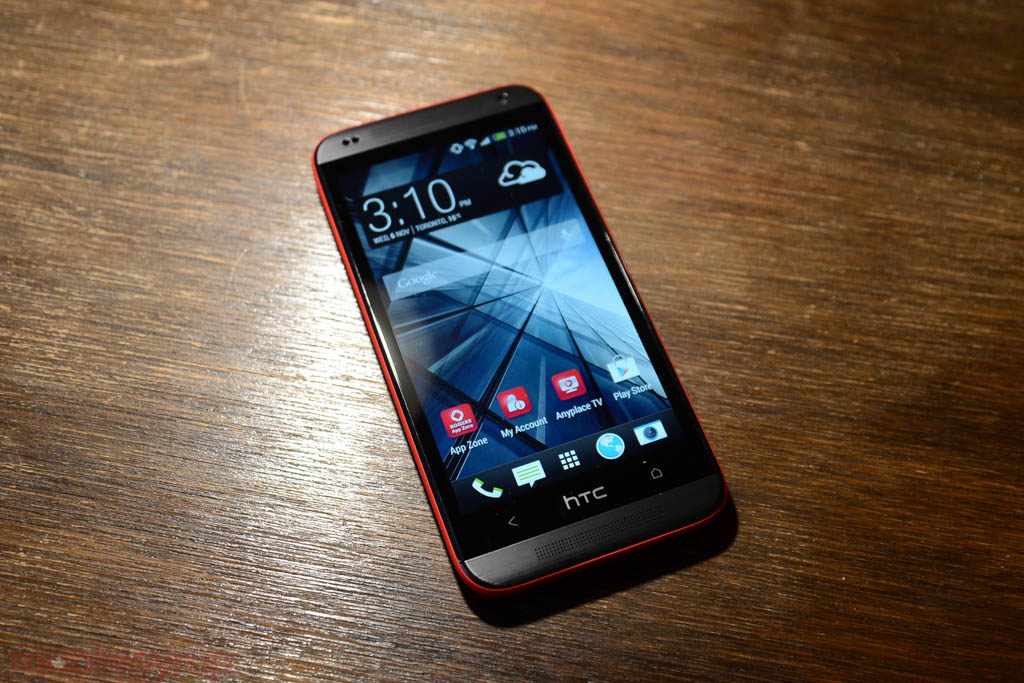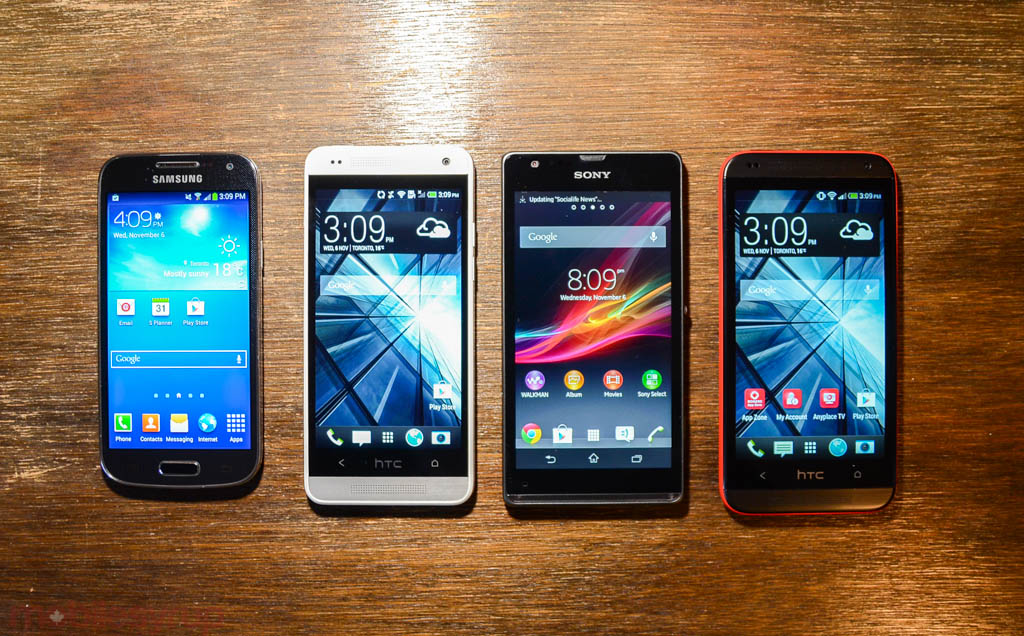
There are a lot of smartphones out there, and I’ll be the first to admit we don’t do a great job reporting on the lesser-known ones. It’s always exciting to cover a powerful flagship with an extensive feature set, but many factors, from price to size, lead people to purchase cheaper, smaller, less powerful devices.
As the days grow short and the holiday offers long, we’re going to look at four Android devices that sit comfortably in the entry- to mid-range of the market, priced from $0 to $149.99 on a 2-year term. Of course, this is not an exhaustive list, and does not take into account other platforms like Windows Phone or BlackBerry. That being said, the mid-range market is mostly served by Android in Canada; TELUS offers the Nokia Lumia 625 for $300 outright, and the three incumbents sell the BlackBerry Q5 for around $400, but the best deals are still on Android. The iPhone 5c can be had for under $100 on contract but still demands nearly $600 when purchased without a term.
The four devices we’re going to look at, from least to most expensive (based on today’s outright costs), are:
- HTC Desire
- Sony Xperia SP
- HTC One Mini
- Samsung Galaxy S4 mini
HTC Desire
- Android 4.2.2 w/ Sense 5.0
- 4.5-inch 960×540 pixel Super LCD2 display
- 1.4Ghz dual-core Snapdragon 400 SoC w/ Adreno 305 GPU
- 1GB RAM, 8GB internal storage (expandable with microSD)
- 5MP rear camera w/ BSI sensor, f/2.0 lens
- LTE connectivity (AWS, 2600Mhz)
- BoomSound dual front-facing speakers
- 2100mAh battery
- 134.5 x 66.7 x 9.88mm
- 130 grams
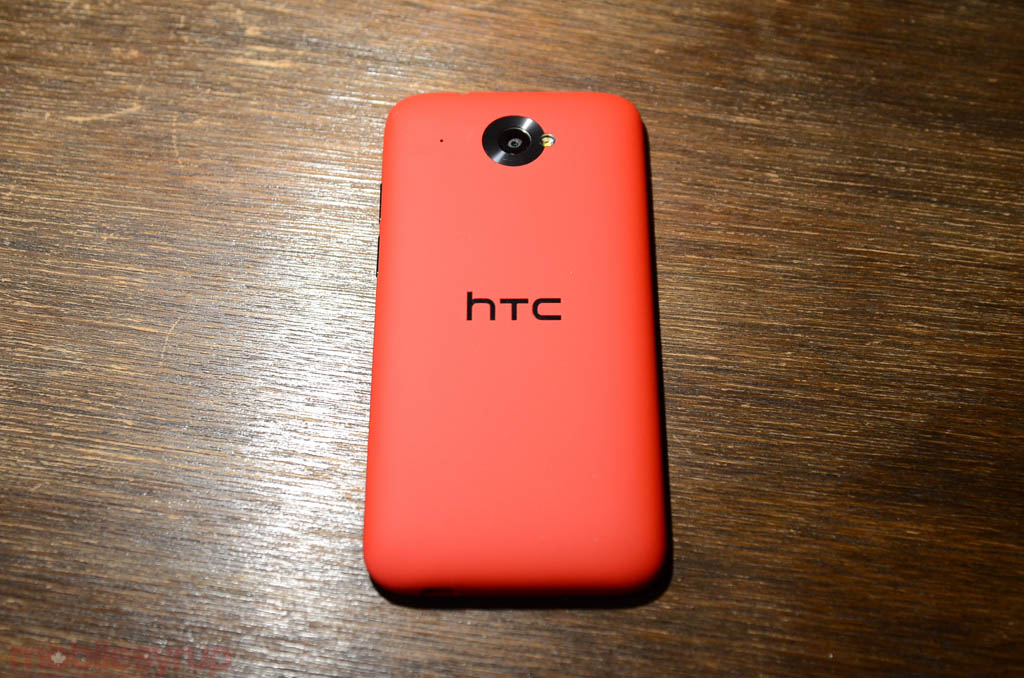
To be honest, this one came out of level field for me. The Desire brand hasn’t had a lot to work with since the Incredible series was replaced by the One variants, but this is easily one of the best values on the market today.
Running a snappy dual-core Snapdragon 400 processor and outfitted with a 2100mAh battery, LTE connectivity and a really capable 5MP BSI camera (think an upgraded version of the sensor found in the HTC Windows Phone 8S), this is a really good phone for the price. Though the 4.5-inch qHD screen doesn’t match the vibrance and sharpness of its One Mini counterpart, the Desire has a lovely matte backing that, on Rogers at least, comes in a gorgeous red finish, and the build quality is remarkably sound.
Furthermore, it runs the same version of Android as the more expensive HTC One Mini, with the same improvements made to Sense 5.0, including BlinkFeed and an excellent camera app. Like the One series, the Desire boasts dual front-facing speakers with BoomSound, and though they don’t match them in volume and quality, they’re still far better than the majority of smartphones three times the cost.
Where the Desire falls short is in the same areas as the others: memory and internal storage. Luckily, there is a microSD slot for expandable storage, but users will want to ensure they don’t download too many apps that run processes in the background.
The Desire 601 is available on Rogers, Fido, Bell and Virgin for $0 on a 2-year term and $300 outright.
Highly Recommended
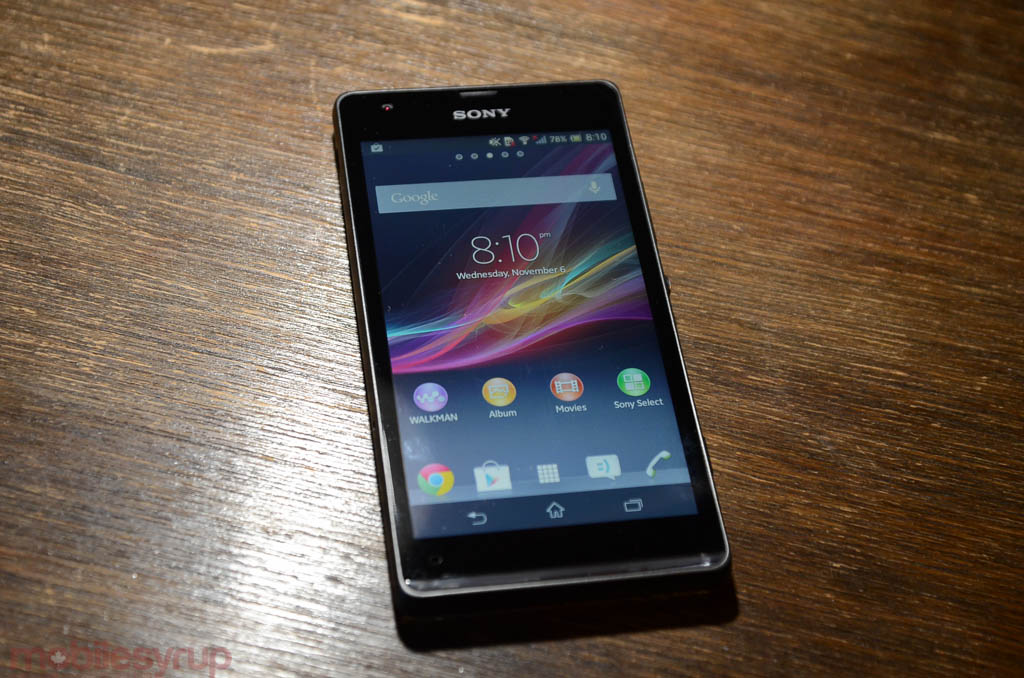
Sony Xperia SP
- Android 4.1.2 Jelly Bean w/ Sony customizations
- 4.6-inch 1280×720 pixel LCD display
- 1.7Ghz dual-core Snapdragon S4 Pro w/ Adreno 320 GPU
- 1GB RAM, 8GB internal storage (expandable with microSD)
- 8MP rear camera w/ hardware shutter button
- LTE connectivity (AWS )
- 2370mAh battery
- 130.6 x 67.1 x 9.98 mm
- 155 grams
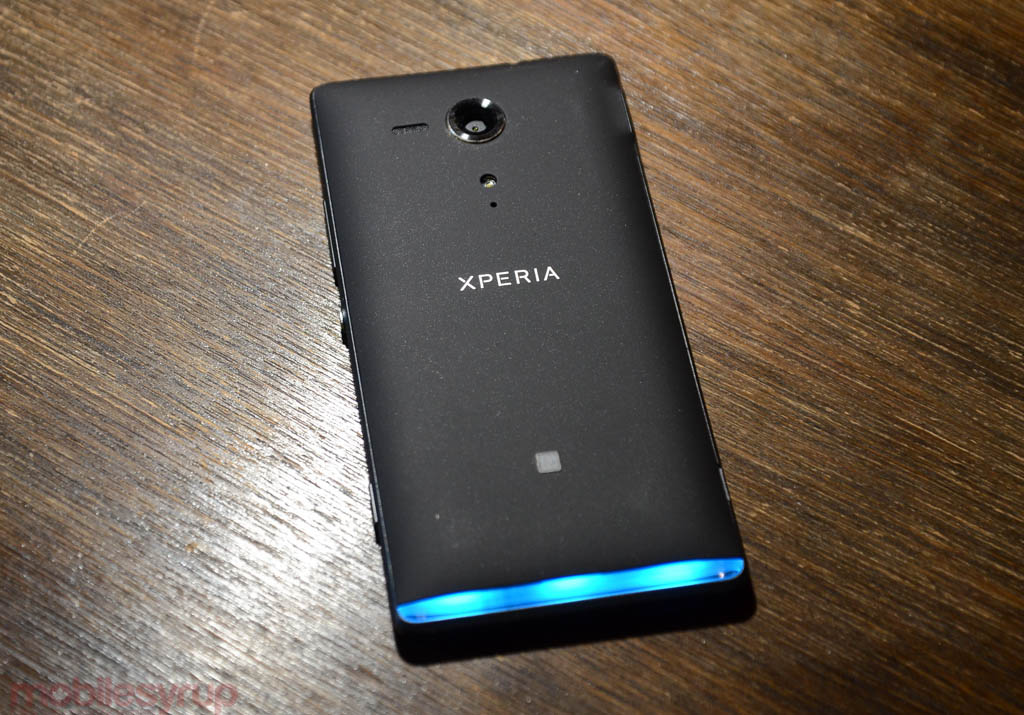
The Sony Xperia SP looks really nice on paper, and in person you wonder how they got the price so low. Like the HTC One Mini, the SP has premium specs, including a 720p display and modern-generation processor, but costs nearly half of the leading flagship devices.
At first, it’s hard to tell why this is; the Xperia SP is made of a sturdy, compact shell, and features many of the same brushed metal considerations as the Xperia Z. But when you get down to the specifics, it’s easy enough to find the nips and tucks. The display is pretty disappointing, with limited viewing angles and muted, grey-inflected colours. The camera, too, while it boasts the Exmor R brand, produces grainy and underwhelming photos.
But these are forgivable when you consider the overall package, and that the phone boasts a fast processor, plenty of battery headroom and a chassis that will hold up to wear and tear over time. The display is one of the highest resolution for the price, so you’ll have to decide whether you’re willing to trade density for desirability. Personally, I’d pick a vibrant, rich, responsive qHD screen over a washed-out 720p, but it’s worth comparing in-store to make that decision.
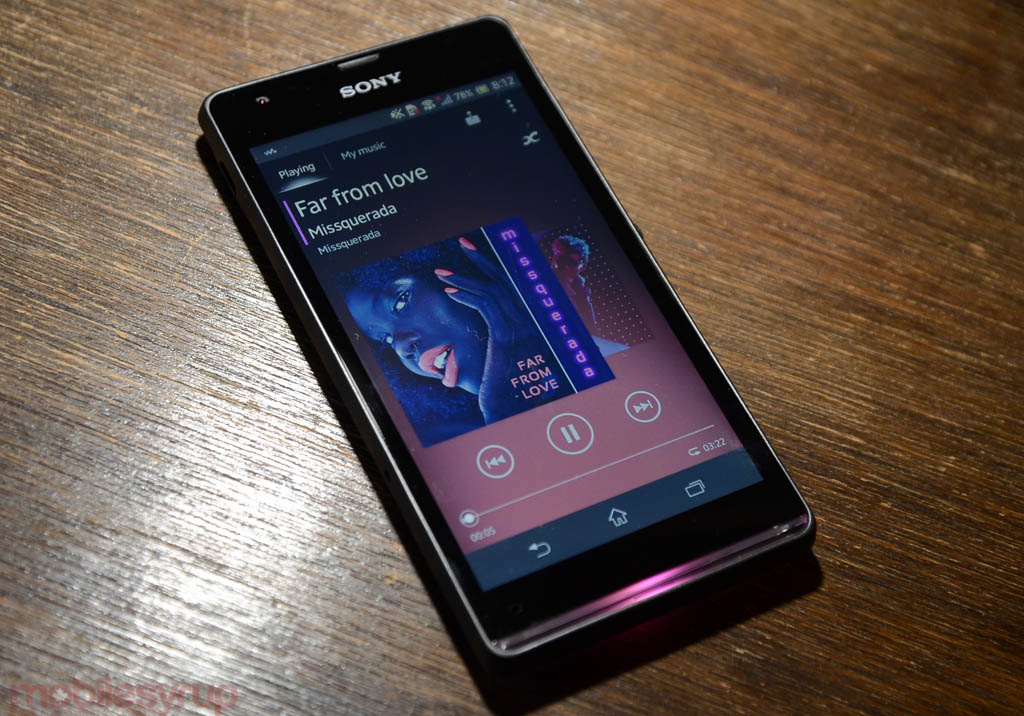
On the plus side, the processor is extremely fast, and it contains the same GPU as the Nexus 4. The camera does take good shots in the right conditions, and is boosted by an excellent Sony camera app. And, of all the devices in this roundup, the SP feels the most sturdy. Its coolest feature is also its most gimmicky; a light bar pulses colours to the beat of songs, videos and incoming notifications. It rings around the entire device, and corresponds to the colour of supported apps on screen.
Unfortunately, the Xperia SP is running the oldest version of Android of the bunch, and there is no likelihood of an update to 4.2 or 4.3 anytime soon.
The Sony Xperia SP is available on Rogers, Fido, Bell, Virgin Mobile for between $0 – $30 on a 2-year term and $300 – $325 outright.
Recommended with reservations
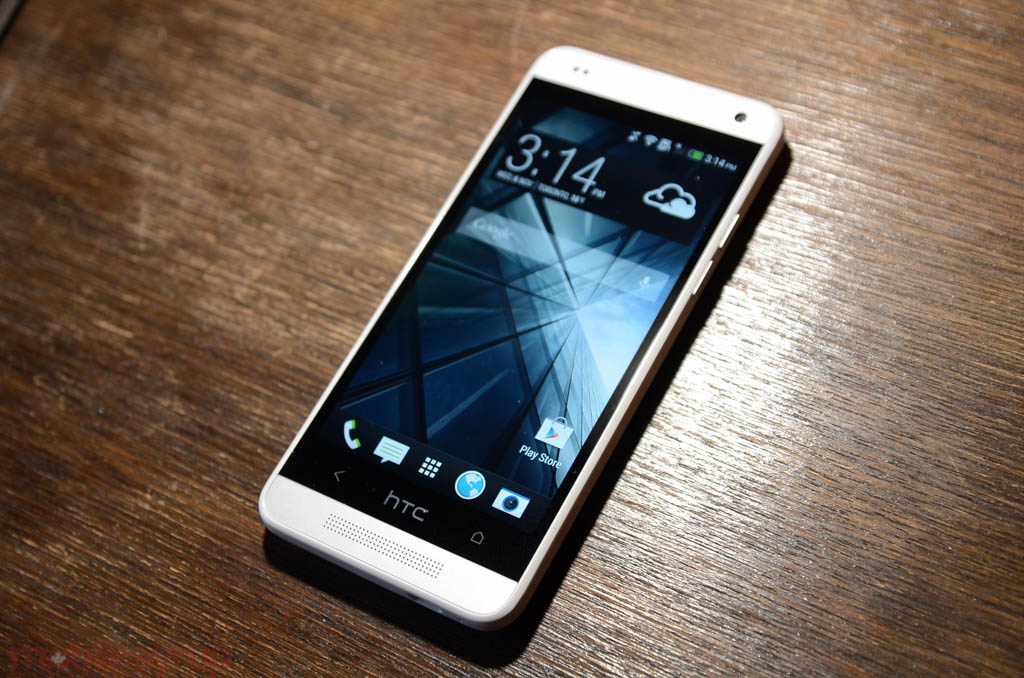
HTC One Mini
- Android 4.2.2 w/ Sense 5.0
- 4.3-inch 1280×720 pixel Super LCD2 display w/ Gorilla Glass 3
- 1.4Ghz dual-core Snapdragon 400 SoC w/ Adreno 305 GPU
- 1GB RAM, 16GB internal storage)
- 4MP Ultrapixel w/ BSI sensor, f/2.0 lens, Zoe support
- LTE connectivity (AWS)
- BoomSound dual front-facing speakers
- 1800mAh battery
- 132 x 63.2 x 9.3 mm
- 122 grams
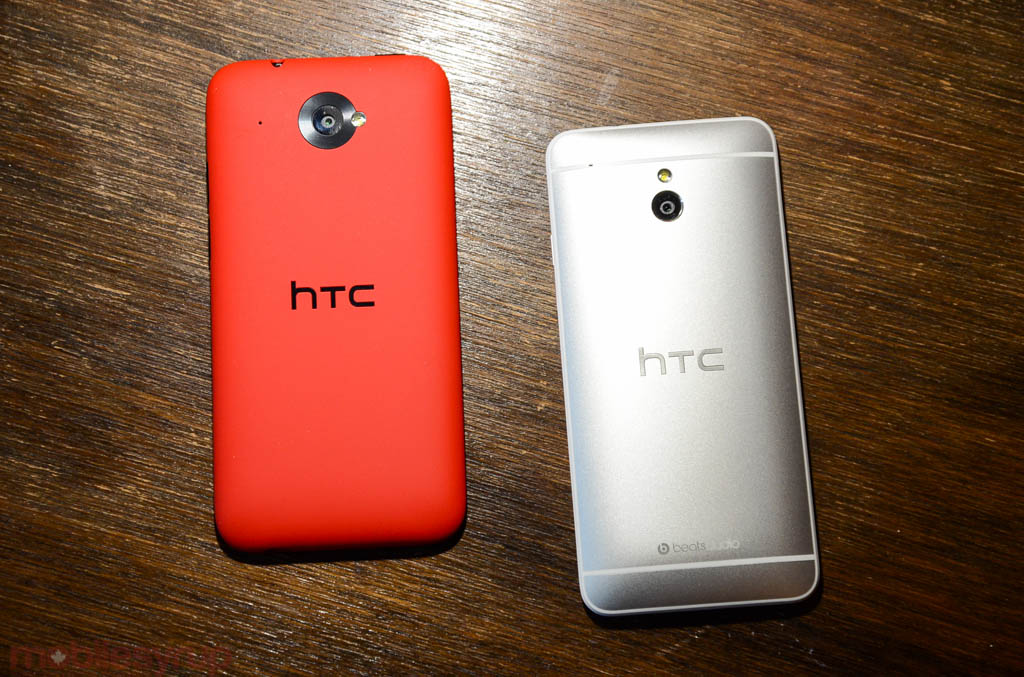
Considerably more compact than the Desire, the One Mini is the slightly cheaper and smaller version of the popular (and in-house favourite) HTC One.
Boasting one of the best screens we’ve ever seen on a compact device, the Mini retains much of the charm of its bigger brother(s), but loses the unibody metal finish in favour of an aluminum front and back with white plastic siding.
Though the sacrifices made to bring the Mini’s price down are understandable, it’s unfortunate that the company didn’t future-proof it by outfitting more than 1GB of RAM in the chassis. With the same 1.4Ghz Snapdragon 400 processor, Adreno 305 GPU and version of Android 4.2.2, the One Mini performs almost identically to the $100 cheaper Desire. Where it comes out on top is in the camera department, sharing the same 2um pixel size as the full-sized One (though without the optical image stabilization), capturing lively, colour-rich shots in even the most trying of lighting conditions.
The One Mini’s build quality is also tremendous, and the size will appeal to those who found the One too unwieldy to use with one hand; the 4.3-inch device is 5.4mm shorter than its larger counterpart. More to the point, this phone just feels amazing in the hand, the kind of precision that is usually reserved for flagship devices. It’s nice to know that HTC did not skimp in the build department, despite the presence of plastic around the edges.
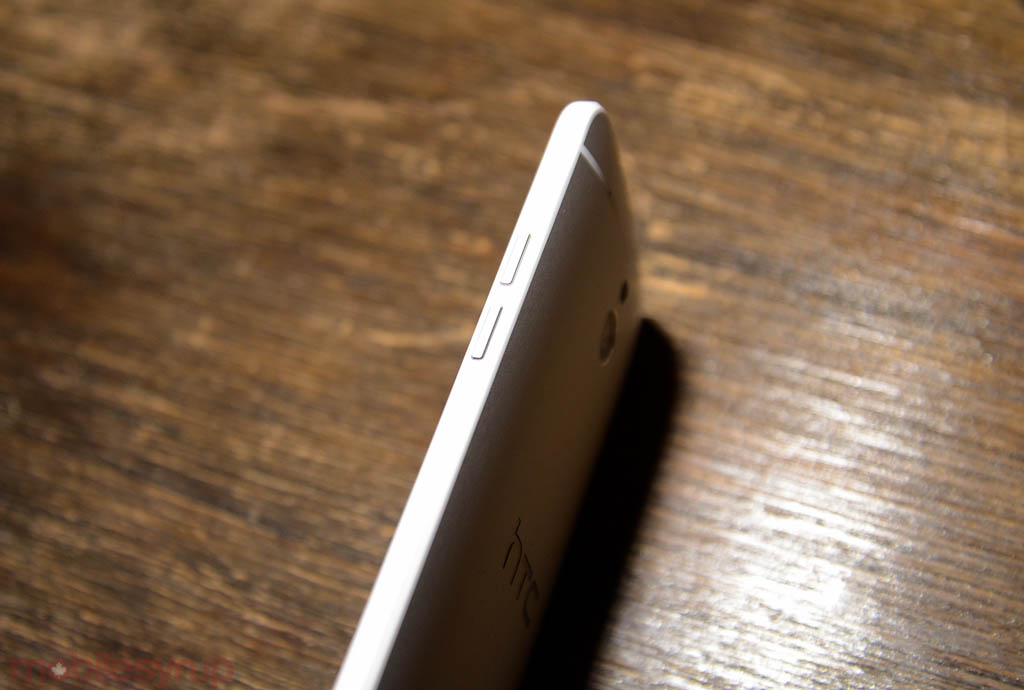
Battery life is a concern with the One Mini, as the 1800mAh internal cell is quite a bit smaller than the others in this list. But throughout my brief time with the phone, I had no issues keeping it alive well into the evening; the Snapdragon 400 SoC sips power, and the screen is considerably less demanding on its GPU than the larger HTC One’s. I’m still torn as to whether I like Sense 5.0 — and this applies to the Desire, too — but it’s grown on me in recent months. BlinkFeed is an interesting addition, but I look forward to the phone being updated to Sense 5.5, which includes a toggle to disable the functionality altogether.
The issue with the One Mini is price: at $100 on a 2-year term and $400 outright, this is getting into “should I/shouldn’t I” territory. Should I spend $50 more (on contract) or $200 more (off contract) and go for a full-sized HTC One (or any number of other devices), or shouldn’t I? Should I just buy a cheaper HTC Desire and wait until the next generation, or shouldn’t I? Because the One Mini is already well behind the curve in terms of specs, you have to consider the entire package: it’s hard to find a phone this well made, with this high-calibre a camera, and this amount of internal storage, for $100 on contract. But there are likely better deals around, and the device can’t get by on looks alone.
The HTC One Mini is available on Rogers for $99.99 on a 2-year term and $399.99 outright.
Recommended
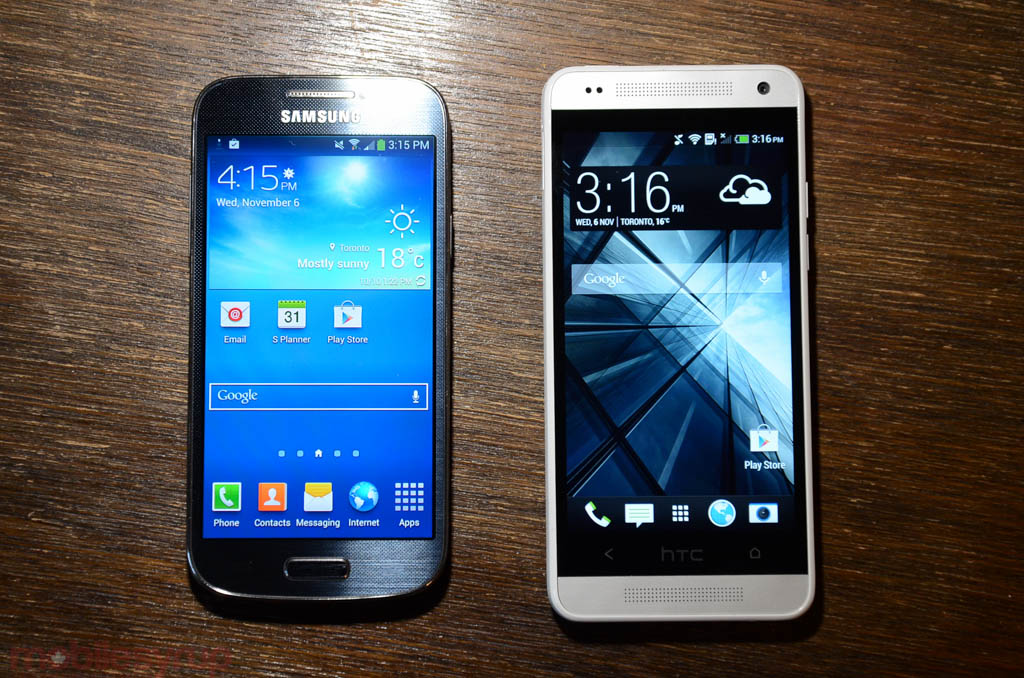
Samsung Galaxy S4 mini
- Android 4.2.2 w/ TouchWIZ
- 4.3-inch 960 x 540 pixel Super AMOLED display
- 1.7Ghz dual-core Snapdragon 400
- 1.5GB RAM, 16GB internal storage (expandable with microSD)
- 8MP rear camera
- 1900mAh battery
- LTE support (AWS/2600Mhz)
- 124.6 x 61.3 x 8.94 mm
- 107 grams
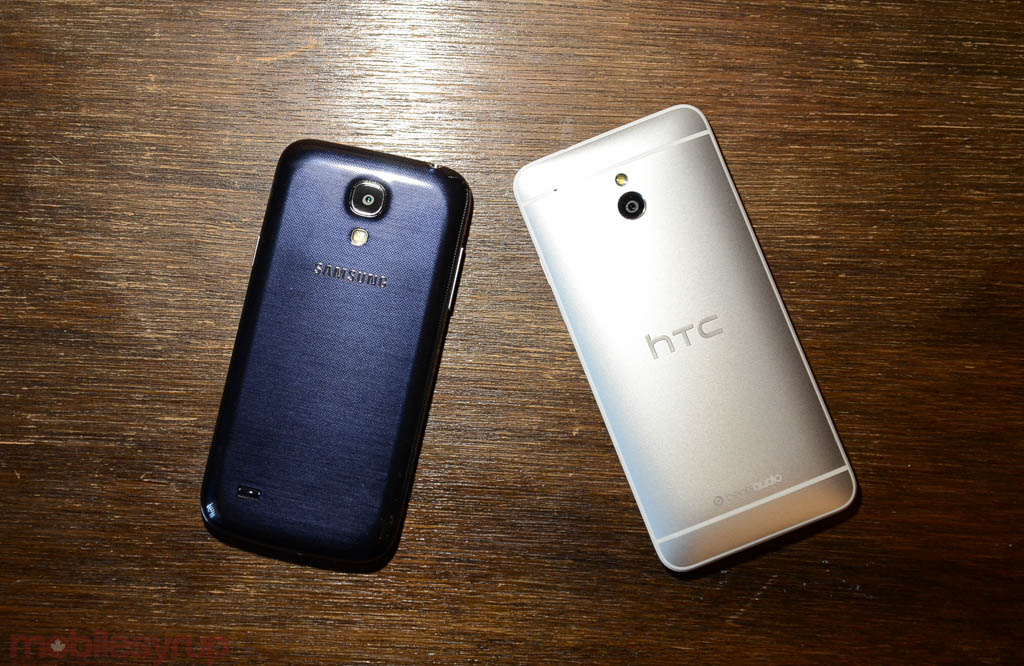
Easily the lightest and most compact of the four devices, the Galaxy S4 mini is also the strangest. Why does it exist? It meets all the criteria of a flagship device — fast dual-core processor, LTE support, excellent camera, 1.5GB RAM — but is hobbled by a qHD display. On Bell and Rogers, it is being sold for $150 on contract and $450 outright, right up there with the HTC One and Moto X, but on TELUS it is being marketed as a mid-level device, free on contract and $400 outright. This is due to the former two carriers selling it under the Smart Picks (Rogers) or Voice & Data Lite (Bell), which offers less expensive monthly plans; TELUS is selling it for less up front with the promise of a larger monthly plan. Thankfully, all three variants come with 16GB of internal storage, a nice boost from the standard-issue 8GB in the international model.
At the same time, the Galaxy S4 mini derives its design from a much more modern place than its specs would suggest. It possesses the dimpled textures and considerably reduced bezels of the Galaxy S4, and comes with most of that device’s software, from the too-many-to-count camera modes to Group Play and gesture support. Indeed, it’s the fastest device of the bunch, too, with a 1.7Ghz dual-core processor and 1.5GB RAM, which makes it more capable of running future versions of Android.
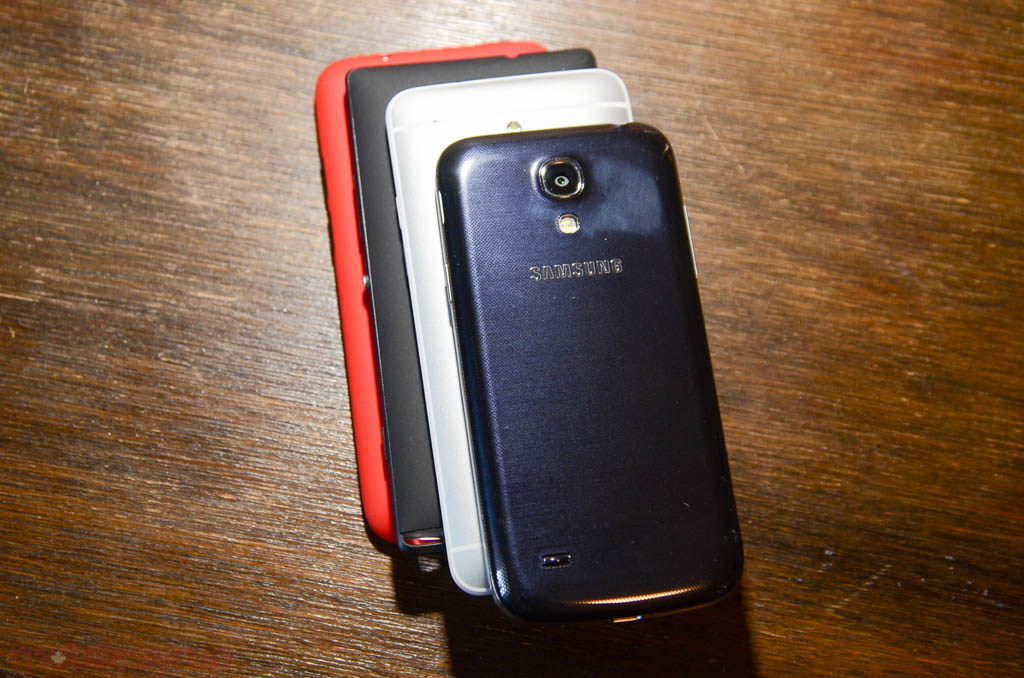
Because the GS4 mini possesses the same 8MP camera module as the Galaxy S3, Galaxy Note 2 and Galaxy Mega, it should take the best shots of the bunch. If not for its low-resolution screen, I’d easily recommend it, and the added cost, over the HTC One Mini, but it’s not a clean-and-shut case. With Samsung, you have a removable battery — which lasts longer, I found — and many more software features (that may or may not be used), but the screen on the One Mini is so much better that it negates many of the S4’s advantages.
If you’re looking for a device that’s going to last you a full contract 2-year contract cycle, the S4 mini is likely the better bet. But if you’re considering upgrading to something better in a year or so, and are looking for something a bit more well-constructed, the HTC One Mini is the way to go.
The Galaxy S4 mini is available in black or white from Rogers, TELUS, Bell and Koodo for between $0 and $150 on a 2-year term, and between $400 and $450 outright.
Highly Recommended
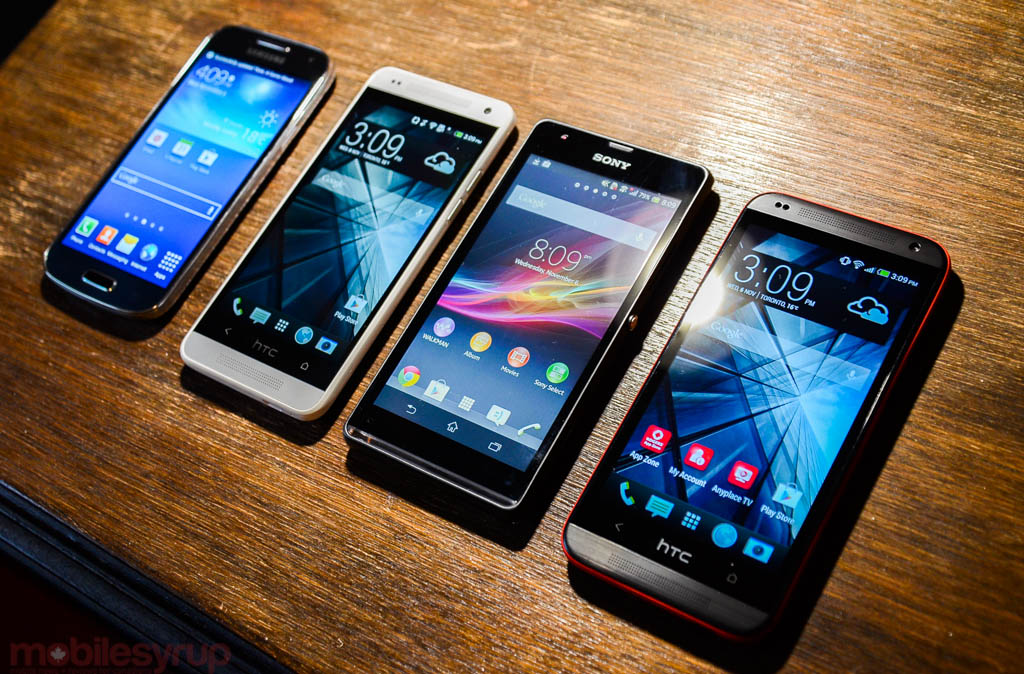
Let me tell you this in closing…
You really can’t go wrong with any of these devices. The HTC Desire is the king of cheap and the S4 mini the king of, well, less cheap (at least on TELUS; the Rogers and Bell versions are vexingly overpriced). In the middle, you have the high-quality build of the Sony Xperia SP and the exemplary design of the HTC One Mini.
Now, a lot of you will say, “Just buy a Nexus 5. It’s wayyyyy better.” Yes, well, it’s better in a lot of ways, but it’s also not necessarily the phone people want. Many consumers want compact, light and inexpensive, and purchasing the Nexus 5 on contract at a carrier is not going to be cheap.
The main takeaway from this experience has been the pleasant realization that Android is no longer terrible in the entry- to mid-range, which is a very different experience to just a year ago. Handset manufacturers are able to design sound hardware and include high-performance specs while retaining a relatively good margin on each device. All four of these smartphones can do everything you need them to, and only fractionally slower than many top-of-the-line products.
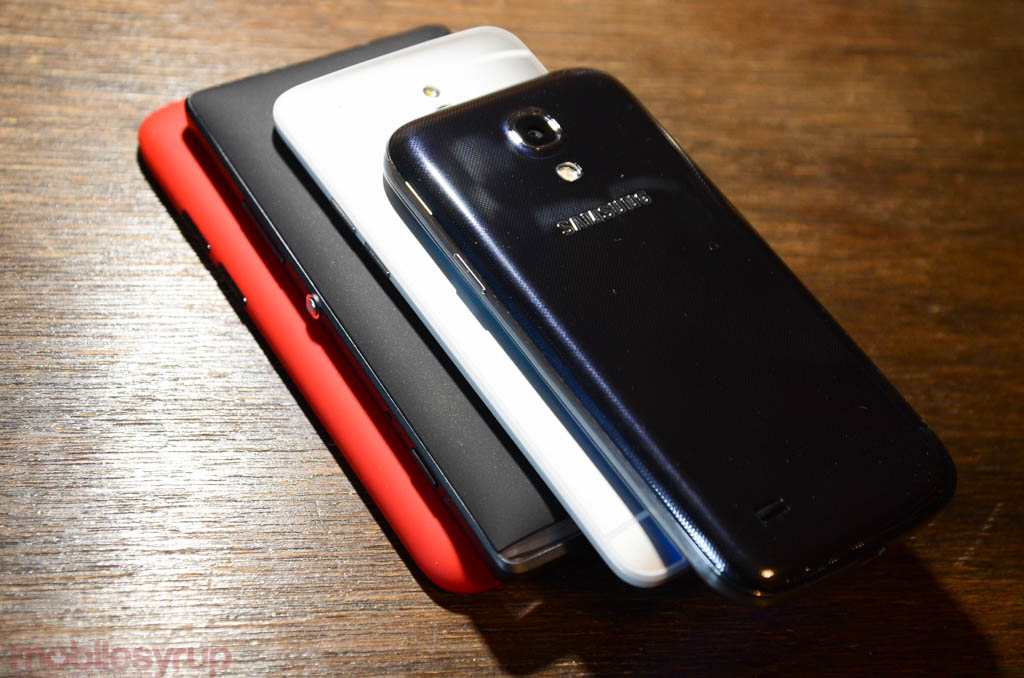
MobileSyrup may earn a commission from purchases made via our links, which helps fund the journalism we provide free on our website. These links do not influence our editorial content. Support us here.

